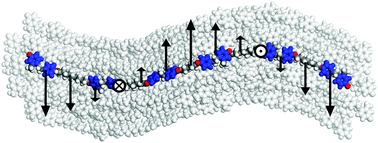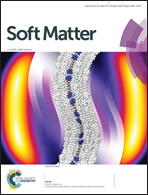Twist-bend nematic phase in biphenylethane-based copolyethers†
Abstract
The main-chain liquid crystal (LC) copolyethers in which the nematic–nematic phase transition was first experimentally observed were revisited and re-characterised. Grazing incidence X-ray scattering revealed that the low-T nematic (Ntb) phase could be highly aligned by shearing, more so than in previously studied bent LC dimers. This was evidenced by a four-point wide-angle X-ray scattering pattern, which originates from convolution of two tilt distributions. Through intensity simulation the orientational order parameter associated with each of the distributions, as well as the conical angle of the Ntb phase, was calculated. Information regarding the polymer chain conformation was obtained using polarised infrared spectroscopy. The findings suggest the average conformation of the chains is a helix, and that the bend angle between mesogenic units is inversely related to temperature. All experimental evidence, including a jump in birefringence at the Ntb–nematic (N) phase transition, shows that copolyether samples mirror the behaviour of bent LC dimers over the transition. This confirms that the low-T nematic phase in copolyethers is indeed the same as that in LC dimers, now known to be the Ntb. The unusual broadening of transition peaks in complex heat capacity, obtained by modulated DSC experiments, is discussed.



 Please wait while we load your content...
Please wait while we load your content...